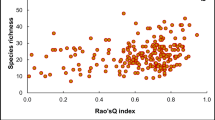Abstract
Howmiller & Scott (1977) presented an ‘Environmental Index’ based on thorough knowledge of the ecological demands of species of freshwater oligochaetes frequently found in North American waters. These authors emphasized the fact that common diversity measures do not utilize information about the ecological attributes of the constituent species but rather about community structure. A modification of the ‘Environmental Index’ is here presented with the aim of increasing its sensitivity in Europe and possibly also in North America. Four ecological groups are here preferred to the original three, and the ecological valence of the ‘key-species’ Tubifex tubifex is discussed at some length. Whereas most environmental and diversity indices remain little affected by changes in the total abundance of oligochaetes, the modified index is sensitive to such changes. Comparisons are made with two of the most popular diversity indices applied to specific situations, i.e. the Shannon-Weaver index and Simpson's index.
In spite of recommendation in pollution manuals, indices of diversity may be inadequate in correctly characterizing situations of nutrient enrichment of freshwater environments. In the present study it is stressed that low diversity is usually found at both ends of the trophic scale and high diversity, which is supposed to characterize a clean and unstressed environment, is generally obtained in zones of transit between oligotrophic and eutrophic conditions — a likely result of the ‘nonequilibrium state’ described by Connell (1978) from coral reefs and rain forests in the tropics.
Similar content being viewed by others
References
Brinkhurst, R. O., 1974. The Benthos of Lakes. The MacMillan Press Ltd., Lond. 190 pp.
Cairns, J. Jr., Albough, D. W., Busey, F. & Chanay, M. D., 1968. The sequential comparison index — A simplified method for nonbiologists to estimate relative differences in diversity in stream pollution studies. J. Wat. Pollut. Cont. Fed. 40: 1607–1613.
Connell, J. H., 1978. Diversity in tropical rain forests and coral reefs. Science 199: 1302–1310.
Elster, H. J., 1966. Über die limnologischen Grundlagen der biologischen Gewässer-Beurteilung in Mitteleuropa. Verh. int Ver. Limnol. 16: 775–785.
Goodnight, C. J. & Whitley, L. S., 1960. Oligochaetes as indicators of pollution. Proc. 15th ann. Waste Conf., Purdue Univ.
Howmiller, R. P. & Scott, M. A., 1977. An environmental index based on relative abundance of oligochaete species. J. Wat. Pollut. Cont. Fed. 49: 809–815.
Hurlbert, S. H., 1971. The nonconcept of species diversity: a critique and alternative parameters. Ecology 52: 577–586.
Margalef, R., 1957. Information theory in ecology. Gen. Syst. 3: 36–71 (Transl. from Mem. Real Acad. Sci. Artes, Barcelona 32: 373–449).
Milbrink, G., 1978. Indicator communities of oligochaetes in Scandinavian lakes. Verh. int. Ver. Limnol. 20: 2406–2411.
Milbrink, G., 1980. Oligochaete communities in pollution biology. The European situation with special reference to lakes in Scandianvia. In: Brinkhurst, R. O. & Cook, D. G. (Eds.). Aquatic Oligochaete Biology. Plenum Publishing Corporation, N.Y., 433 pp.
Pielou, E. C., 1969. An Introduction to Mathematical Ecology. Wiley-Interscience, N.Y., 286 pp.
Simpson, E. H., 1949. Measurement of diversity. Nature 163: 688.
Sládecek, V., 1978. Relation of saprobic to trophic levels. Verh. int. Ver. Limnol. 20: 1885–1889.
Wiederholm, T., 1976. Chironomids as indicators of water quality in Swedish lakes. NLU Information 10, Naturvårds-sverkets Limn. Undersökning, 20 pp.
Wiederholm, T., 1980. Use of benthos in lake monitoring. J. Wat. Pollut. Cont. Fed. 52: 537–43.
Wilhm, J. L., 1967. Comparison of some diversity indices applied to populations of benthic macroinvertebrates in a stream receiving organic wastes. J. Wat. Pollut. Cont. Fed. 39: 1673–1683.
Author information
Authors and Affiliations
Rights and permissions
About this article
Cite this article
Milbrink, G. An improved environmental index based on the relative abundance of oligochaete species. Hydrobiologia 102, 89–97 (1983). https://doi.org/10.1007/BF00006072
Received:
Revised:
Accepted:
Published:
Issue Date:
DOI: https://doi.org/10.1007/BF00006072




